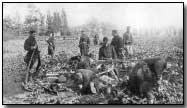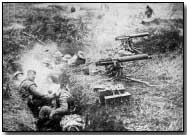Memoirs & Diaries - A Gunner's Adventure
 One of the most exciting
experiences which befell me during the War happened on the Somme front on
June 26th, 1916, four days before the great Allied offensive. Our
battery, of which I was a signaller, was in action at Sailly-au-Bois, and
was to support the attack on Gommecourt Wood on July 1st.
One of the most exciting
experiences which befell me during the War happened on the Somme front on
June 26th, 1916, four days before the great Allied offensive. Our
battery, of which I was a signaller, was in action at Sailly-au-Bois, and
was to support the attack on Gommecourt Wood on July 1st.
It was my turn to be on duty at the "O.P.," so off I started on my journey, accompanied by two other comrades, one acting as a runner. We fully realized that a hot time was in store for us, his duty being to carry messages back to Headquarters, which were situated in Hebuterne village, should occasion arise in any emergency, such as telephonic communication breaking down or other unforeseen circumstances arising. My other comrade, Signaller Thompson, was to assist with the work that we were to do at the "O.P."
Leaving the battery at half-past seven, the three of us made our way over the plain, passing Hebuterne Wood and along the road, and through a winding of trenches known as "Wood Street," to a place called "The Grotto" and some more trenches known as "The Keep," well-known spots in this sector, where more often than not, one had to keep very alert of machine-gun fire, owing to the fine overlooking position the Hun had at his command.
The morning was fine and bright with the sun just breaking through. We leisurely made our way along the trench leading to our observation post, which was situated at a junction of the support and front-line trenches, arriving there about nine o'clock.
After testing our telephone lines and receiving the "O.K." from the stations in communication with us, we awaited the arrival of the major and Lieutenant Hasper, who took a very brave and active part, saving my life, of which I will give you further details later.
After we had been on the look out for some hours our infantry put over a smoke screen. Jerry had been on the alert for several weeks, knowing too well that we had been preparing for a big offensive. In fact more than once he had put notice boards on the top of his trenches, intimating that he was already aware of our intentions and suggesting a number of likely dates for the offensive to take place. Being in such readiness, he at once realized what we were at. His artillery opened fire on our front-line trenches, many shells getting direct hits on our "O.P ." We at once made for our dug-out.
 We
had spent many days and long nights in making the place as secure as our
means would allow. The stairs led down to a depth of 16 feet, the
walls being held by corrugated iron. At the bottom there was a room 12
feet square. At the left-hand corner an airshaft had been cut, leading
to the top of our trench, some 12 feet from the parapet.
Unfortunately, this emergency exit had not been quite completed, having no
support should the walls of earth cave in, which, as you will learn, was the
cause of our major and my two comrades losing their lives.
We
had spent many days and long nights in making the place as secure as our
means would allow. The stairs led down to a depth of 16 feet, the
walls being held by corrugated iron. At the bottom there was a room 12
feet square. At the left-hand corner an airshaft had been cut, leading
to the top of our trench, some 12 feet from the parapet.
Unfortunately, this emergency exit had not been quite completed, having no
support should the walls of earth cave in, which, as you will learn, was the
cause of our major and my two comrades losing their lives.
By the time we had reached the bottom of the dug-out the trench outside had been destroyed by the continuous shelling, causing the entrance to our dug-out to collapse, thus cutting off our means of escape to the trench outside.
After some few moments, which seemed like hours, our major decided that Lieutenant Hasper should make an attempt to be lifted up the airshaft. We now began at once, to pull out the timbers that had been blown into the dug-out to put under the feet of our comrade, in assisting him to make his escape, pushing the pieces of wood under each other, the higher he got up the shaft. After some considerable time Lieutenant Hasper reached the top. The bombardment was now at its height, but, thank the good Lord! he managed to get away without getting hit, to bring back a rescue party of half a dozen officers and men.
The time which elapsed between Lieutenant Hasper's escape and his return with the rescue party seemed endless. At last we heard shouts, and the next instant Lieutenant Hasper was being let down the airshaft. Unable to obtain a rope, our rescue party formed themselves into a human chain.
We now wondered who would be next to be got out. The major decided that he would make an attempt, but after many despairing efforts he was not able to get more than a few feet from the bottom: his figure was more robust than Lieutenant Hasper's, and our task of lifting him was much more difficult. While all this had been going on I had been praying very quietly, asking the Almighty to save me. I shall never forget those moments of anxiety.
The major then said, "Well, Bradbury, you have a go." This was the last I heard or saw of him.
I began to claw my way up towards daylight. The German guns were now belching forth with more intensity than ever, and the work of the rescue party was becoming more difficult every moment. All this time I was working my way inch by inch, grappling the clay walls of the airshaft, and digging my fingers in as far as I could. I was now becoming very exhausted, and only the encouragement which I received from those up above made me go on.
Every moment, I kept on repeating the words, "I cannot do it," only to hear Lieutenant Hasper's voice calling "...For God's sake, man, stick it!"
 I
now had worked myself half-way up, and the distance between myself and my
rescuers still seemed a very long way. It was getting late in the
evening and darkness was creeping upon us, the bursting of the enemy shells
on top of the dug-out making a very vivid scene.
I
now had worked myself half-way up, and the distance between myself and my
rescuers still seemed a very long way. It was getting late in the
evening and darkness was creeping upon us, the bursting of the enemy shells
on top of the dug-out making a very vivid scene.
I could now see the outstretched fingers of another officer, Lieutenant Hibbins, who formed one of the rescue party and, try as I could, with all my strength, I was still unable to reach them. The exertion which I was putting into my efforts made the perspiration run down me, I felt that the veins in my hands were at bursting point.
At last I felt the tips of his fingers, and, after a couple of almost superhuman efforts on my part, he grabbed my wrists. The feeling that ran through me at this moment I cannot describe, realizing that I was now safe. At last I was landed safely at the top, each rescuer putting every ounce of energy behind his pull.
Shells were falling heavily as I lay in a semi-conscious and half-dazed condition on the ground.
Our corporal, Frierley, and some more men were now endeavouring to dig as hard as they could to widen the shaft to rescue Major Heard. After working many hours they had to give up, and the major and my other two comrades had to be abandoned in the collapsed dug-out.
Our infantry in the front-line trenches, which were only a few yards away, were depleted in number, the Boche attacking very heavily as I lay on the ground.
It was now eight o'clock in the evening and I made my way back along the shell-battered trenches, being assisted by Corporal Frierley, who was awarded the Military Medal in this action.
I was met by our captain, who afterwards took command of the battery. He congratulated me upon my escape, Eventually we arrived back at the gun-pits.
Lieutenant Hasper was awarded the Military Cross. I shall never forget him. This incident is only one of the many great deeds of heroism enacted during the Great War.
Gunner N. H, Bradbury enlisted in the Territorial service on May 6th, 1909, and was mobilized on August 4th, 1914, his unit then being the 3rd London Brigade, R.F.A., which stayed in England until October 4th, 1915, when it embarked for France, the first action being at Sailly-au-Bois, November 1915, January 27th, 1916, the Kaiser's birthday anniversary, he was in the front line at Loos, going from there to the Somme, where he took part in the Somme offensive of July 1st, 1916.
After leaving there the brigade was in the Battle of the Somme. Afterwards took part in the capture of Vimy Ridge, April 10th, 1917, when, after doing good work there, the brigade was designated the 282nd Brigade, R.F.A., being Army field artillery, Other: engagements were: Third Battle of Ypres, July 31St, 1917; Pilkem Ridge; St. Julien, August 3rd, 1917; Poelcappelle, August 19th, 1917; Passchendaele Ridge, November 6th, 1917; V Army retreat, March 21st, 1918. On the date of the Armistice at Cambrai.
First published in Everyman at War (1930), edited by C. B. Purdom.
Photographs courtesy of Photos of the Great War website.
French tanks were used for the first time in battle on 17 April 1917, when the 'Char Schneider' (as they were known) was used during the Second Battle of the Aisne.
- Did you know?
